T Voltage requirements for different circuits vary greatly, such as microcontroller based circuits require 5V, motor controller or relay driver circuit requires 12V, and other digital circuits require 3.3V.
If a circuit does not receive its rated voltage and current, it will not function properly. Therefore, it often makes sense to use a variable power supply.
In this circuit, we will design a laboratory power supply to provide voltage and current requirements for testing various circuits and devices.
Here are the lab basics:
1. Must provide a regulated output
2. It must supply the required current to the circuit under test
3. Its output voltage must be adjustable to the required voltage
4. Must have a digital display for voltage and current
Various laboratory power supplies are available to meet all of the above requirements, but they are typically quite expensive.
Other problems include:
- BIG in size
- Bulky and heavy
- Not portable
- Takes up a lot of space
Unfortunately, most electronics enthusiasts, teachers or students cannot afford these power supplies in their homes or laboratories. But we have a solution.
Let's build a compact and portable laboratory power supply with all the essential features.
Specifications
1. Output voltage regulated with LM317 and LM7805 voltage regulator chips
2. Adjustable output voltage: 1.25 to 23 V
3. Maximum output current 2A
4. Linear and accurate output voltage
5. Digital display for voltage and current
6. Dual power supply (1) variable power supply: 1.2 – 23 V (2) fixed power supply: 5 V
7. Compact and lightweight design
8. Portable and takes up little space
9. Total cost around 425/– Rs
This power supply uses the popular voltage regulator IC LM317. It has a simple and easy to build circuit. It also has a digital VA meter that displays output voltage and current. Let's start.
Circuit Diagram
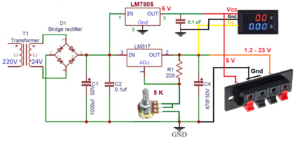
Circuit diagram of laboratory power supply using IC LM317 and LM7805.
As shown in the diagram above, the circuit uses LM317 and LM7805 voltage regulator chips, as well as some additional components such as a rectifier bridge, capacitors, resistors, and potentiometer.
Circuit Connections
- The primary of transformer T1 is connected to 230 V AC input
- Its secondary connects to the AC input terminals of the rectifier bridge
- The output of the rectifier bridge is provided as input to both the LM317 and LM7805 ICs
- A 5K potentiometer connects to the tuning input of IC LM317
- The 5V output of the LM7805 connects to the output socket and VCC power of the digital VA meter
- The LM317's variable output also connects to the output socket and provides a digital VA meter signal input
Circuit operation
- T1 is a 12-0-12 @ 2A transformer, which steps down the 230V AC input to 24V AC, providing it as input to the rectifier bridge D1
- The bridge rectifier provides a rectified output which is filtered to pulsating DC through capacitors C1 and C2 4. This output is provided as an input to both voltage regulator ICs.
- The LM7805 generates a regulated 5V output, which is used as the supply voltage for the digital VA meter
- The 5V output is also taken from the external connector so that it can be used in the external circuit
- The LM317 generates a variable output voltage from 1.2 to 23 V as the potentiometer is varied
The equation for the LM317 output voltage is:
Vout = 1.25 (1 + R2/R1)
Here… R2 = 5K potentiometer and R1 = 220 ohm
So when R2 = 0
Vout = 1.25 (1 + 0) = 1.25 V
And when R2 = 5000
Vout = 1.25 (1 + 5000/220) = 30 V*
*Note: Maximum output will be 23 – 24V because the AC input is 24V
This output is provided as signal input (yellow wire) to the digital VA meter. The variable output voltage is displayed on the meter. Furthermore, the variable output voltage is connected to the external connector.
Circuit assembly and housing
The complete circuit and a transformer are housed in a specially designed MDF box as shown below.
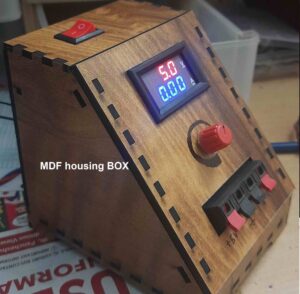
Complete circuit prototype and transformer designed in MDF box.
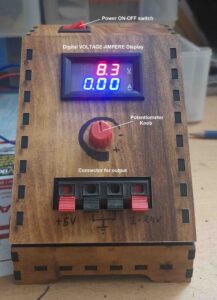
The open MDF box with the different components.
The digital display, potentiometer and output connector are fixed on the front panel as shown in the image below. There's also a power button at the top.
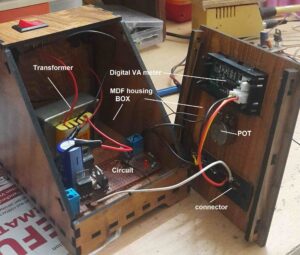
The MDF box with voltage amperage digital display, potentiometer knob and switch.
Now, let's break down the costs. Here is the BOM (bill of materials)…
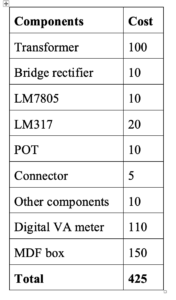
This simple laboratory power supply can be built at home for less than 500/- R. Now it's your turn!
Here's a YouTube video for a closer look at how to build this home lab power supply:

